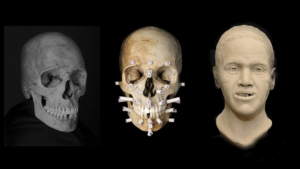
Facial reconstruction is a method used in the forensic field when a crime involves unidentified remains. Facial reconstruction is usually performed by a sculptor who is an expert in facial anatomy. This sculptor could be a forensic artist but it’s not a requirement. Either way, the sculptor will work with forensic anthropologists to interpret the features of the skeleton that will ultimately help reveal the age, sex and ancestry of the victim. The sculptor can also reveal anatomical features (features that are related to the body structure) such as facial asymmetry, evidence of injuries like a broken nose or teeth that were lost before death. These factors are determined by using either the three-dimensional reconstruction technique or a two dimensional reconstruction technique.
The three dimensional reconstruction technique requires the sculptor to place tissue markers on the skull at specific points so that when the clay is placed the reconstruction looks as close to the victim as it can be so that there is a better chance of the victim being identified. The points where the markers are placed is determined by generalized measurements of depth based on age, gender and ethnicity. Fake eyes are also added to the reconstruction. Various measurements are also taken to determine eye placement, the width/length of the nose and the length/width of the mouth. The eyes are centered and are also placed at a specific depth. The skull must be positioned on a stand in the Frankfort Horizontal position, which is the agreed upon normal position of the human skull. Once the tissue markers are glued to the skull the sculptor can then begin placing clay on the skull and sculpting it so that a face is formed. Once the basic shape has been constructed the sculptor can begin to make the skull look similar to the victim. The sculptor does this by using all of the information that has been made available to them by the forensic anthropologist. This information can include the geographic location of where the victim lived or the victims life style. To help make a possible identification of the unknown victim sculptors will add hair, either in the form of a wig or clay representing hair. A sculptor can also add various props such as glasses, articles of clothing, or anything that could generate a possible identification.
The first of the two dimensional reconstruction techniques like the three dimensional reconstruction techniques involves placing tissue markers on the skull in specific places and specific depths using the generalized measurements that have been determined by age, sex and ancestry. Once the skull is in the proper position (the Frankfort Horizontal) on the stand, the skull is photographed. The skull is photographed at a one to one ratio from both the frontal and the profile views. While photographing a ruler is placed along the skull. After the photographs are taken they are enlarged to life size and then taped in the Frankfort Horizontal position on two wooden boards next to each other. Once the photographs are attached transparent natural vellum sheets are taped directly over the printed photographs. Once the set up is completed the artist can start to sketch. The artist sketches the skull by following the contours of the skull and using the tissue makers as guidelines. Measurements for the eyes, nose and mouth are performed the same way in this technique as they are performed in the three dimensional reconstruction techniques. Hair type and style is determined by either estimating based off of ancestry and sex, evidence found at the scene, or by information received from the forensic anthropologist or another professional. All procedures are documented, and the notes taken are collected.
The second two dimensional technique involves reconstructing a face from a body that is decaying. For this method the artist uses their knowledge about how the soft tissue of the skin lies on the skull and how the body decomposes to create a reconstruction of what the victim may have looked like before death.
The two dimensional techniques are more cost effective than three dimensional reconstruction and they save time, and ultimately accomplish the same thing.
Back to Crime Library
|
|
|
